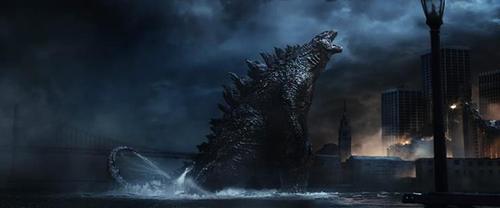
The King of Monsters returns to theaters. (source)
The first film in Warner Bros. & Legendary Pictures’ rebooted American Godzilla franchise stomped into theaters this weekend. To give you the most textured, accessible perspective on the movie, we asked Contributing Editor Christina Harrington, a relative neophyte to the franchise, and Patrick Stinson, Deadshirt’s resident kaiju expert, to review the film together. Warning, there are SPOILERS ahead.
Patrick Stinson: As a longtime Godzilla fan, I pretty much decided with everyone else from the trailers and pre-release hype that unlike ‘98, this team captured the character of Godzilla. What was surprising about the film was nearly everything else.
Christina Harrington: And while I love giant monster ANYTHING, I’m not very well versed on Godzilla in particular. To my great shame, the only other Godzilla movie I’ve seen is the ’90s one. Which, uh, starred Matthew Broderick, and that’s basically all I can remember about it. That and a hilarious chase sequence through Madison Square Garden.
Patrick: And that is your shame. Particularly since there were six other acclaimed Godzilla movies released that decade that you didn’t even know about. Anyway, what was your take on the marketing campaign?
Christina: Nothing really stood out to me, beyond the commissioning of original movie posters from unknown artists on the tumblr account. That created a bunch of gorgeous and varying pieces that were launched about one a day the week before the movie premiered. Besides that, the trailers were wonderfully deceptive. All too often movie trailers give away the entire fucking movie (see, for example, any one of the Transformers movies), but they kept a lot of the secrets and cool twists very close to the vest. And I’m so glad they did!
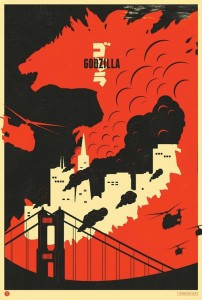
The winning entry to the Godzilla poster contest, by Jim Viola. (source)
Patrick: Yeah! From my perspective, the whole exercise was essentially a great prank. The goal was to lure in a typical cynical Hollywood audience with the promise of disaster porn + Godzilla. They created whole new effects shots for this purpose. The trailers and the whole first act prepare you for this, then the movie takes a right turn and introduces a whole other threat. By the time director Gareth Edwards springs the surprise that Godzilla’s going to save the day, the audience is prepared for it. In other words, he made us expect the original destructive Godzilla, then subbed in the heroic ‘70s/Marvel/Hanna-Barbara Godzilla and made us like it!
Christina: Yeah that seemed to be one of the many nods back to classic Godzilla flicks. Like that reveal is an important part of the Godzilla mythos.
Patrick: Godzilla hasn’t been very overtly heroic for a long time. That assures that even folks like me who followed him into the 21st century got to have a nostalgic twinge. But the intellectual clout of the script makes it, uniquely, not a “kiddie” film at all. Gareth Edwards proceeds from the premise that somehow, someway, the Godzilla who was seared by the first hydrogen bombs and the Godzilla who defeated the Smog Monster are one and the same, and he imagined what that creature would be like with the most modern technology.
Christina: The reveal that there would be two other kaiju in the film was pretty well done, I think. And holding off on showing the big monster battle was also a good choice, in my mind. We got to focus on the human element of the film, which is super fucking important when a very large portion of the movie is going to be killing off said humans. We get attached to people, to faces we find familiar, so the stakes feel real and the tension lands. I’m thinking in particular of the train sequence, the suspense of it and the real pain behind watching those characters get slaughtered.
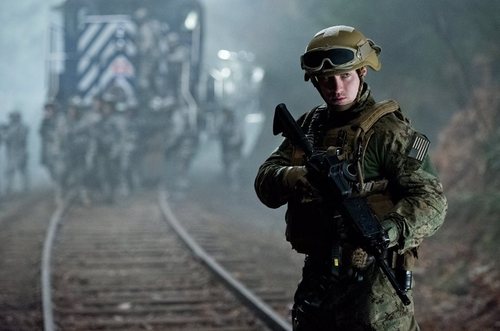
While the marketing campaign focused on superstars like Bryan Cranston or Godzilla himself, the real lead of the film was Aaron Taylor-Johnson. (source)
Patrick: The most consistent single complaint I’ve yet seen is that the airport battle should have been more fully shown to us, and while I fully understand why that complaint is being made, I can’t agree. It was a genius move to cut away, and worth the risk of feeling like a tease. And while I was greedy for more monster action, they say the best chef is the one who leaves the diner wanting more. This is a minimalist movie, and that’s why no one could have made it, or made it so well, in 2014 Hollywood other than Edwards and writer Max Borenstein.
Christina: [Deadshirt EIC] Dylan said those moments gave him “Kaiju Battle Blue Balls.” It was a little frustrating, I have to admit, but the ending battle in San Francisco made up for it. My favorite part of this movie was the fact that Godzilla was that balance, that he was a force for good or at least not just some mindless animal wreaking havoc. And while I enjoyed the movie, I have to get into the parts that were off for me, namely the fridging of Bryan Cranston’s wife in the first fifteen minutes of the film.
Patrick: I didn’t have that specific complaint, maybe because I knew it was coming from the trailer. But, I think in general this film had very strong plot and design work but rather weak character work. The leads were very generic, and both Cranston and Binoche felt defined by their deaths, not their lives. Watanabe was quite good in a thankless role as the scientist who somehow knows what the script wants us to think of Godzilla. Focusing on the human element isn’t a bad idea. In fact it is practically the definition of the early Godzilla films. But many of them had more memorable characters than “the unluckiest bomb disposal guy in the world.”
Christina: I agree that most of these characters fit into pretty standard archetypes, but that was a blatant fridging. It was fucking textbook. She’s one out of only three named women in the film, by the way, and her sole role is to be immediately killed off to create 15 years of guilt and manpain for Bryan Cranston’s character and their son, Ford. I’m increasingly frustrated that big blockbuster films (and TV shows and comics and every other type of media) keep using this trope. It’s insulting, frankly, and it took me completely out of the movie. I actually flipped the screen off in the theater when it happened. By the forty-minute mark it doesn’t even have an impact on the film anymore. Cranston’s character is dead, and Ford could have become the man he is without it happening. His major drive is not revenge on these monsters for his mother’s death, but protecting his family. It was a lazy move by the film’s creative team, and is the best example of bad character writing that plagues this film.
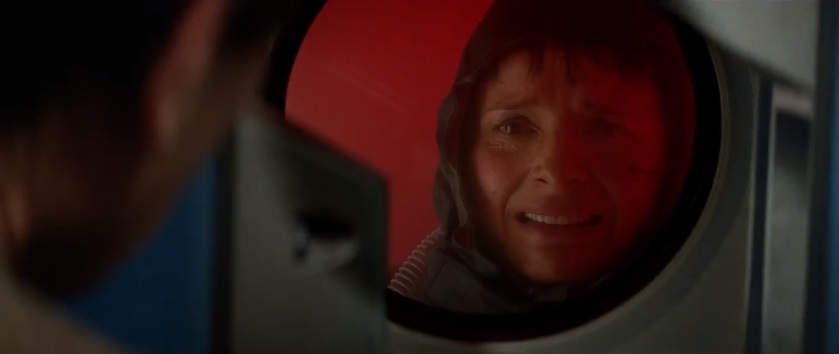
Joe Brody’s nuclear scientist wife (Juliette Binoche) is killed off almost immediately. (source)
Patrick: Absolutely agreed. The closest thing to a triumph for feminism in this film is that the female MUTO was tougher than the male. But in the Deadshirt spirit, perhaps let’s move on to something positive? I was very impressed by the way that the nuclear subtext was woven throughout the movie, not given lip service in just one scene. Bomb tests, vulnerable power plants, military nukes, even Yucca Mountain. They made a 60 year old theme feel vital and relevant.
Christina: Yes! They certainly didn’t shy away from it. I especially enjoyed the opening credits, where they reviewed the history of nuclear power, but with the history of Godzilla woven into it. The credits set the scene for the rest of the film, I think, and let us know that this is a major part of the plot. They could have been a bit more subtle about it, but not all metaphors have to be quiet ones. Was I the only person trying to read the redacted script during the credits while it was being redacted? I love alternate history shit.
Patrick: NO YOU WERE NOT, I was going crazy reading those. Actually “secret history” stuff usually irks me, but here it was necessary. It was a way for Godzilla to be old and new at the same time. Godzilla wears the full burden of his 60 years IRL, without having to spin an elaborate sci-fi alternate Earth that takes away from the relevance. Above all else, the treatment of the nuclear theme tells me that my beloved Godzilla is in good hands.
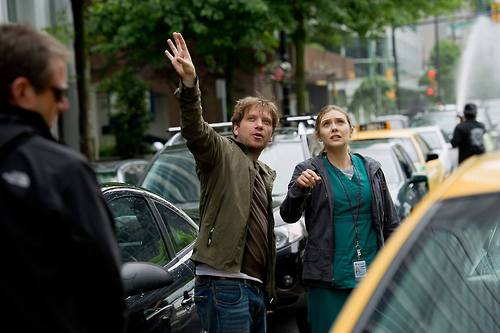
Gareth Edwards directs actress Elizabeth Olsen. (source)
Christina: Looking back on the ’90s Godzilla film, having now seen this one, I can see how much of a misstep it really was. They did nothing to acknowledge the history of Godzilla films, nor did they try to build on it. This film seemed to do that better. It’s an American movie and an American Godzilla, yes, but the filmmakers seemed more willing to work within the traditions of these films, rather than ignore them completely. Am I correct in assuming that?
Patrick: Absolutely true. One of the classic Godzilla producers was a producer of this movie, and the head of Toho Studios said that they had “brought back the Godzilla of his childhood.” Ironically we could have seen this years ago — there are major similarities between this and a U.S. Godzilla script that Jan de Bont almost shot in 1994. It got bumped due to cost anxieties, and the 1998 team stepped in. One of many fascinating what-ifs in the history of Godzilla. This is better than even the 1994 story, though, particularly on the history and themes.
Christina: That’s so cool! The best thing I can say about this film is that it really gets me excited about watching the Godzilla back catalog. Luckily I can, because there’s a whole lot of Godzilla films that have been put on Netflix recently. Do you think the Japanese will follow this one up with a Godzilla film of their own?
Patrick: They did in 1999, but they won’t now. First, the money isn’t there for Toho to make them anymore, particularly since Hollywood effects are such a tough act to follow. Second, “Godzilla 2” just got announced with Edwards attached. This is going to be a big-budget franchise for a while. In fact, between this and Pacific Rim, this could be a new golden age of monster films, going head to head with superheroes.
Christina: The idea of a sequel to this film intrigues me. I kind of want it to include an entirely new cast of characters, in a brand new country. And maybe somewhere there hasn’t been a Godzilla film yet? I think I’d love to see Ken Watanabe in the next film though, because I really love him. He’s great! Plus, his face in this movie was priceless. It was a look of pure incredulity at his surroundings. A look that says: “What the fuck is going on and how do I stop this from continuing?”
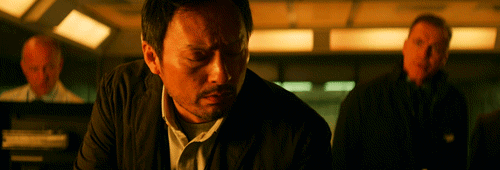
Thank you, official Godzilla Tumblr, for anticipating our needs.
Patrick: I suspect that Watanabe’s Serizawa may assume a similar role as the character of Miki Saegusa, the only recurring character in the Godzilla series 1989-1995, uniting those films into one continuity while allowing each to tell a totally different story. For many reasons, I hope that we’ve seen the last of Ford Brody. Let them have a break. In fact, the strongest sequel hook I see is the tension between the military’s opinion of Godzilla and public opinion. I’d like to see an attempt on Godzilla’s life lead to calamity — that fits in with the theme of hubris in this film.
Christina: That would be an organic tension, and I hope it gets mined in the sequel. Can we get a female lead in the next film? I know that’s probably not going to happen, but it would make me really happy.
Patrick: Well Hunger Games is making mad money, and I’m hoping to see a new trend of female action protagonists that Godzilla 2 jumps on to. In fact, the Godzilla series has a long history of female protagonists starting with Miki. Despite that being an even tougher sell in Japan, GMK (2001) stars a Japanese version of Lois Lane, and Godzilla X Mechagodzilla (2002) is a character piece about a female mecha pilot. If Edwards really loves Godzilla, he should twig on to this. Big biceps are not helpful against kaiju anyway.
Christina: I’m really hoping there are more kaiju in any sequels. The surprise of there being more than just Godzilla in this film is the thing that really made me like it. And while the designs of the monsters felt maybe too JJ Abrams-y to me at times, their EMP abilities went a long way to contemporize a kaiju threat, like you mentioned above. Those attacks were effective, and rightfully so. I don’t know the pantheon of monsters Godzilla has fought in the past (beyond Mothra, because everyone knows who Mothra is), but is there anyone in particular you’d like to see modernized in the next film?
Patrick: As a biology nerd and a script/plot nerd, I want to say that the MUTOs were perfect. Just perfect. For Godzilla 2, speculation is centering around Mothra, but personally I want to see King Ghidorah. As Godzilla’s archenemy, they can even tie him into the secret history of atomic monsters established in this one.
Christina: The MUTOs were great! I’m less anxious about nuclear holocaust than I am about no longer having the ability to get online. That’s an exaggeration, but honestly? Only a slight one. My life (and most people’s lives) are permanently woven to electricity and everything that comes from it.
Patrick: Additionally, it made plausible the idea that our modern military can’t just scrape targets that huge off the face of the planet.
Christina: The MUTOs seem to be the perfect metaphor for the film itself: they have flaws, yes, but they’re modernized kaiju that fit well within the ranks of those that came before.
Patrick: I wanna see it agaaaaaaaaaaain. Bottom line.
Godzilla is in theaters everywhere now.


One thought on “Godzilla: A Two-Headed Monster Review”
Comments are closed.